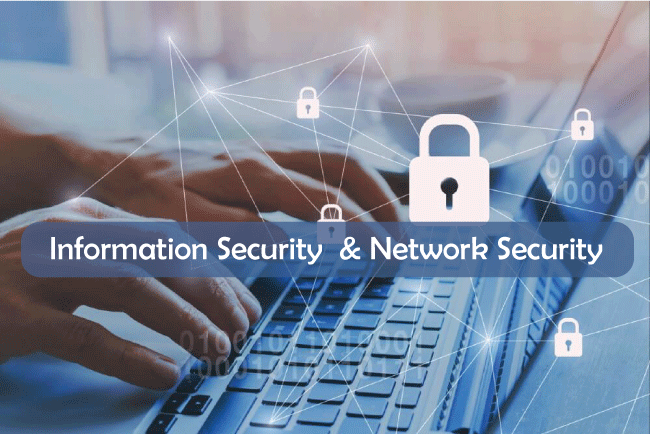Information security & Network securityInformation securityA crucial component of network systems, information security works to safeguard data and information from unwanted access, use, disclosure, interruption, alteration, and destruction. The security of network systems is now more crucial than ever due to society's growing reliance on digital technology and the internet. In this post, we'll look at the idea of information security in network systems, how important it is, and some of the most effective methods and guidelines for doing it. What is Information Security in Network Systems?A combination of practices, policies, and procedures called information security in network systems is intended to safeguard the privacy, availability, and integrity of data and information stored, processed, and sent across a network. It entails locating potential risks and vulnerabilities in network systems, putting those risks under control, and continuously assessing and enhancing the network's security posture. Why Is Information Security Essential in Network Systems?Information security is essential in network systems for a number of reasons:
Key Techniques and Best Practices for Information Security in Network Systems
The confidentiality, integrity, and accessibility of data and information must be protected in network systems by means of information security. Access control, encryption, firewalls, IDPS, patch management, staff training, and stakeholder awareness are all tools that businesses can use to reduce the risk of security incidents and keep stakeholders' trust. In order to remain ahead of new threats and vulnerabilities, it is crucial to continuously evaluate and enhance the security posture of network systems. Network securityNetwork security has become increasingly important in the current digital era for maintaining the integrity and safety of our networks. The protection of a computer network and its data from illegal access, theft, or damage is referred to as network security. Security precautions must be taken in network systems to protect the network from various forms of assaults, including malware, phishing, denial of service (DoS) attacks, and more. The installation of firewalls is one of the crucial phases in network security. A firewall is a piece of hardware or software that monitors and regulates network traffic, basing its actions on pre-set security rules. A firewall can stop potentially hazardous traffic from entering the system and can stop unauthorized users from accessing the network. The use of encryption is yet another crucial component of network security. Data is transformed into a secret code via encryption to prevent unauthorized access. Sensitive information, like passwords, credit card numbers, and other personal data, is frequently secured via encryption. Network security also entails the deployment of antivirus and anti-malware software in addition to firewalls and encryption. These tools are made to identify and eliminate dangerous software from the network, such as Trojan horses, worms, and viruses. Anti-malware software is essential for preventing hackers from breaking into networks or stealing critical data. Strong password implementation and access control procedures are also necessary for network security. Access control methods ensure that only authorized users are allowed access to particular regions of the network, and strong passwords are crucial in preventing unwanted access to the network. Monitoring and analyzing network traffic on a regular basis is another essential component of network security. Network managers must keep an eye on network traffic for any unusually high volumes of traffic or traffic coming from unidentified sources, among other signs of suspicious activity. Network traffic analysis can be used to identify and stop attacks before they harm the network. Finally, maintaining network security also entails patching and updating network hardware and software on a regular basis. To keep network hardware and software secure against known flaws and attacks, network managers must often upgrade and patch them. Finally, network security is an important component of network systems. It entails using firewalls, encryption, antivirus and anti-malware software, strong passwords, access control measures, routine network traffic monitoring and analysis, and regular network device and software upgrades and patches. Network administrators can defend the network against different assaults and guarantee the integrity and safety of the network and its data by putting these security measures in place. Difference between Information security & Network security
Protecting sensitive information and computer systems from online threats requires both network security and information security. Despite their near resemblance, the two have some variances. The following are some important distinctions between network security and information security:
While information security and network security are intertwined, they concentrate on separate facets of protecting computer systems and data. Information security is primarily concerned with securing the data that lives on networks, whereas network security is more concerned with safeguarding the network architecture. Both are crucial for defending against online dangers and guaranteeing the privacy, accuracy, and accessibility of sensitive data. To safeguard sensitive data, computer systems, and networks, information security and network security are two key components of cybersecurity. Following are some examples of how network security and information security are used: Applications of Information Security:
Applications of Network Security:
These are but a few of the numerous uses for network and information security. Individuals and organizations can safeguard their confidential information and computer systems from online threats and attacks by putting these security measures in place.
Next TopicSecurity Engineer & Security Architect
|
 For Videos Join Our Youtube Channel: Join Now
For Videos Join Our Youtube Channel: Join Now
Feedback
- Send your Feedback to [email protected]
Help Others, Please Share










